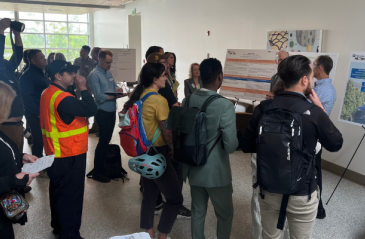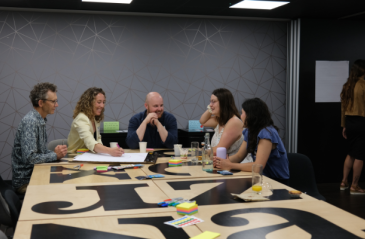
The information barriers holding back climate action and how to break them

Businesses tend to have a more agile approach to large modernisations than governments...
Share articleCore system modernisations involve many stakeholders and communication needs be clear
Share articleTransformation has to be business-driven, with very strong buy-in and leadership from the top
Share articleWe put our vision for government into practice through learning partner projects that align with our values and help reimagine government so that it works for everyone.
When it comes to public sector IT, the buzz is all about the power of digital technologies to transform how governments operate and deliver services to citizens. Certainly that shift is real and transformational.
What is often left out of that discussion, however, is the need for a modern IT backbone to make that digital revolution possible and support the ever-increasing need for agility, real-time information and customisation of services. This backbone - or core system - must be able to process large amounts of information reliably, accurately and securely as well as maintaining the integrity of key data such as citizen records
Governments are increasingly relying on technology to enable complex transformation programmes of their core systems. Although few successful examples exist, it can be done. We hear from three government leaders from around the world about their lessons learned from efforts to transform government - from inside to out.
Mikey Dickerson has swapped life as a systems engineer for Google for a role heading up the US Digital Service (USDS). He tells us how he's getting on
I'm a relative newcomer to government - I've been heading up the US Digital Service (USDS) for less than two years. At USDS we are seeking to improve government computer systems and websites, as well as anticipating future problems and improving how citizens interact online with government more broadly.
There are many differences between the public and private sectors in this field. For example, businesses tend to have a more agile approach to large modernisations - there is a big difference between a food delivery start-up in San Francisco failing to deliver a profit and the failure of a government program to modernise social security disability payments or veteran's healthcare.
At USDS we don't seek to transform vast swathes of government operations in one go. Instead we focus on smaller individual projects because we're not that big an organisation. In any case, the size of some systems - like Medicare processing or tax returns - means we can't solve a whole problem at once. Instead, we seek to solve one piece of the problem at a time which is less risky but can give the mistaken impression that it's not important and what we're doing is not very exciting. This is a perception problem that holds us back but breaking the problem into smaller pieces, where each piece is small enough that it can fail without it being a catastrophe, is another thing that government has to learn how to do.
Similarly, I've found that there is a mindset in government that the only way to engage the market is through spending hundreds of millions of dollars on contractors - even though technology projects fail all the time in very predictable ways. These contractors are given a seven to ten year timeframe and we repeat this pattern again and again and it almost never works.
The only reason I say ‘almost' is because somebody might pop up and surprise me with some success story but I am actually aware of zero success stories of this ever working the way anybody intended. We need to re-interpret this incentives model that people respond to and it's broken because nothing bad happens to people who build products that don't work. At USDS we want to address these issues by helping agencies apply technology in smarter, more effective ways - always with a focus on the customer experience in mind.
Read more: Googling better government
Peter Blaschke knows all about making a public impact. For nearly 10 years he has been at the heart of a billion-euro initiative transferring non-military computer services to a public-private partnership. What has he learned from this experience?
In 2006, the IT and Communications (ITC) system supporting Germany's armed forces was facing a variety of challenges. Not only were systems and processes out of date but many attempted solutions were operating in isolation, leading to inefficiencies and a heavy dependency on numerous outside companies. And in addition, an aging workforce creating capability gaps was further complicating the picture.
Fast forward 10 years and it is a situation transformed. The country's armed forces have some of the most secure and modern infrastructure in Europe. So, how did we achieve this transformation?
A Public-Private Partnership represented the best route forward. This would provide long-term investments; strong governance; the necessary personnel; and the industry know-how that was, at the time, beyond what was available in government and the armed forces themselves.
Project HERKULES is a 10-year, 7.1 billion euro ($10.6 billion) project that began in 2006. It brings together a consortium between the German armed forces (Bundeswehr) and private firms like Siemens and IBM to upgrade non-military IT and communications infrastructure. The result is BWI,which I lead, and is responsible for supplying the relevant IT services involving some 140,000 PCs, 7,000 servers and 300,000 telephones.
The programme has delivered value in different ways. Although not as publicly visible as other government services, the standardised and centrally-managed ITC infrastructure now benefitting Germany's armed forces fulfils the toughest IT security conditions. This transformation, however, would not have been possible without the market itself.
Of course, procurement know-how, including for integration in the existing system, is one element but the market's high investment capabilities and purchasing volume enables the best-possible service. The Herkules contract takes into account the necessity of flexibility over the course of a ten-year project. The Bundeswehr is able to revise the services provided at any time, based on new developments, while still fulfilling its contractual obligations. The contract also had a “modernisation clause” to ensure that the technology would always be kept up to date.
That said, we did encounter varying challenges along the way. We had to take into account the viewpoints and priorities of the three main stakeholders - the federal office, the ministry and the military - and we determined relatively quickly that BWI would have to take a pro-active approach to management and coordination. For example, we ensured early responses to and, when necessary, correction of press reports about the project. Clarity and accuracy of information ensured that our stakeholders were kept abreast of progress at all times.
Looking back, if I was to give one piece of advice to a CIO about to undertake a core systems modernisation programme, I would say it is crucial that they, and they alone, need to be responsible for the budget. They also need the right management personnel in place with a good grasp of structure and governance; multi-project management; staff recruiting and retention change management.
If this combination is fulfilled then they are well placed to say the magic words: “Mission Accomplished.”
Technology has been a constant thread of Greg Farr's 30-year government career. He tells us about what he learned from serving in roles such as second commissioner of taxation for the Australian Taxation Office and chief information officer of the Department of Defence
From my experience in government, I have come to learn that transformation has to be business-driven, with a very strong mandate and buy-in and leadership from the top. You need to make sure you actually understand what it is you're going to do, from the stakeholders' perspective or make sure you can define what success looks like from their viewpoint, so that they can actually sign up for it. And you have to find some really trusted colleagues that you can actually depend on to run the programme and who will still be there when you go, because otherwise what you've started is likely to just fade away.
My time at the Australian Tax Office (ATO) and Department of Defence (DoD) involved substantial changes to the core systems of both organisations. We deployed a two-step approach, starting with phasing in the changes in order to help build up goodwill. It's important to have quick wins because you're going to need it, you're going to step up along the way. This stage-by-stage process allows you to demonstrate value as you go, showing government, citizens and others in the department that you can deliver tangible value, quickly,. And that gives you momentum.
We needed some research capabilities, then we needed some assistance to take that research and put it into what would be the frame of a programme. For a lot of these major transformations of this type, senior executives see them once in their career, which means you don't build up expertise in putting them together. I've seen a couple, but I'm probably the exception rather than the rule. You don't understand the mistakes that are likely to occur, so you need to engage and draw on people who actually do that for a living.
Core system modernisations also involve a myriad of stakeholders - both internal and external - and communication with these groups needs be clear and transparent. At the ATO, this involved recruiting internal ‘change champions'. I looked for people who were not the ‘best mate', but were people who were outspoken, who had street cred, but also had credibility with senior managers. These were people who were prepared to take the time to actually enter into this process instead of whingeing about it. They came up with propositions that weren't just the existing system with some whistles and bells. Instead, it was fundamental things like opening up everything, linking community systems with tax systems, which at the time was very radical. This shows how having a good team in place - which requires investing more in finding and attracting the right people - is absolutely essential to the success of a transformation.
Read more: Taking technology reform forward











